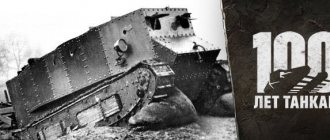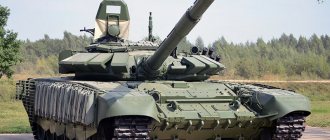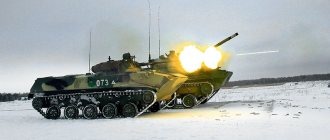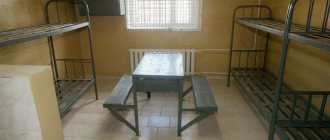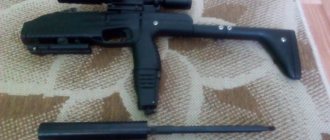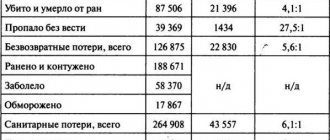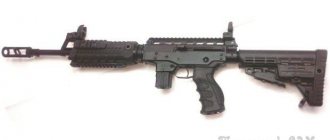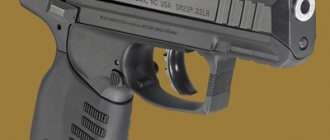Bucket on the trunk
During World War II, the Nazi invaders had the strongest armored forces at their disposal. They consisted of maneuverable light and medium armored vehicles, as well as heavy, powerful tanks. German "Tigers" and "Panthers" with thick armor were a formidable force. In the second half of the war, the Soviet troops were dominated by the maneuverable T-34-85 vehicles.
The IS-2 heavy tanks were also in service, which German tank crews were justifiably afraid of. From a distance, the silhouettes of these two combat vehicles were practically the same. The only thing that caught my eye was the thickening on the muzzle of the larger-caliber gun of the Joseph Stalin tank, which acts as a muzzle brake.
In order to deceive the enemy, Soviet tank crews began to massively use a military trick of a tactical nature - to hide the distinctive feature of the IS-2. Such misinformation brought confusion to the Nazi plans.
Faster mobile T-34-85 vehicles gained a strategic advantage on the battlefield. Taking into account such circumstances, putting a bucket on the muzzle was quite justified.
Artillery gun
Tanks and self-propelled guns use different weapons. The self-propelled gun is an artillery gun on a self-propelled chassis, while the tank is armed with a tank gun, which is mounted in a rotating turret. Unlike a tank, the turret installation of the self-propelled gun is located not in the middle, but in the rear part of the armored hull.
What is the Boomerang armored personnel carrier? More details
Logs on the hull
Initially, the tank hulls were not loaded with foreign objects that did not have direct combat use. Only weapons were installed here. The first cars were not particularly powerful and maneuverable, so the extra load clearly hindered their movement. Some of them broke down even before the battle, others got stuck in the mud of the swampy area.
Practice has shown that under combat conditions, for the full operation of a tank, a certain set of tools and improvised means is required. The main ones are the famous sledgehammer and crowbar. In addition, the tank hull served as a place to install a stove, tarpaulin, shovels, cable, and cross-cut saw. Specially designed boxes were equipped here, inside of which relatively small spare parts and tools were stored. Even modern American Abrams tanks have a special basket for all sorts of things installed behind the turret.
Over time, as tankers gained experience, they came to the conclusion that additional items only strengthened the armor. So they put spare tracks, sandbags and even bed nets there.
During World War II, planks and logs were used to defend against suicide bombers with magnetic pole mines. Thanks to the wooden layer, the magnets did not work.
More modern tanks are equipped with dynamic protection systems, which consist of separate boxes with explosives inside. When a projectile hits, the oncoming explosion weakens the cumulative jet.
From the very beginning of the appearance of tanks on the battle arena, the tradition of getting stuck among large puddles and in swampy areas has become firmly established. Pulling a multi-ton armored vehicle out of the mud was becoming a daunting task. To do this, there had to be another tank or a powerful tractor nearby. Such realities pushed tankers to search for optimal solutions to a possible problem.
How does a tank work?
How does a tank work?
Low-chested, flat-bottomed, Weighed down by itself, With a gun pointed at the soul, A tank going into battle is terrifying. A. Tvardovsky, Vasily Terkin.
What epithets did people who were not familiar with it come up with for the tank? The word that comes up most often is “sullen.” Then comes the “rattling steel box,” which is also sometimes called the “blind box.”
But get to know the tank better, open the turret hatch and sit down on the commander’s seat. The first thing a person will think about when sitting down on the seat of a tank for the first time is the similarity of the internal structure of the tank to a scientific laboratory.
1 — gun barrel; 2 — ammunition rack (shells for the gun); 3 — machine gun; 4 — tank turret; 5 — tower roof; 6 — controller of the electric drive of rotation of the tower; 7 — gun breech; 8 — tank commander’s seat; 9 — telescopic sight; 10 — periscopic observation device for the loader; 11 — commander’s cupola; 12 — oil tank; 13 — fuel tank; 14 - engine; 15 - water pump; 16 - water pipe; 17 — reverse pipe; 18 — water pump drive gearbox; 19 — aft pipe of the water meter propulsion device; 20 — stern pipe damper drive; 21 — oil cooler; 22 — water radiator; 23 — stern pipe damper; 24 — gearbox; 25 — drive wheel of the caterpillar propulsion device; 26—side clutch; 27— caterpillar; 28 — water pump impeller drive housing; 29 — pump impeller; 30 — inlet pipe of the water-jet propulsion unit; 31 — inlet grille of the inlet pipe; 32 — rollers; 33 — rotating floor of the tank’s fighting compartment; 35 — emergency exit hatch; 36 — guide wheel; 37 — control lever for the water-jet propulsion valve; 38 — clutch and brake control lever; 39 — driver’s seat; 40 — gear shift lever.
There is no iron rattling underfoot and no metal rivets in the corners. On the white matte walls, intricately colored rays of the sun play, passing here through the prisms of viewing devices. Neatly painted in protective, silver, black tones, the devices are located in the front, rear, side, in niches and on the ceiling. The beeping of the radio station, the jumping of the needles on the scales of the illuminated instruments, the barely audible buzzing of the umformers will immediately put you in a complacent mood, and the cheerfully winking green and red eyes of the numerous signal lights will make you forget that this is a combat vehicle, and not a mobile laboratory.
But as soon as you look to the right, the massive tank gun lock will bring you back to reality. Here, in the turret, a 100-mm cannon and a coaxial machine gun are installed. They are what make a tank a fighting machine.
The loader rose from his seat to the right of the gun. Next to it, shells are attached to the walls of the tower. Having pushed the projectile firmly into the breech, he pressed the locking device. The weapon is ready for battle. A little in front and below you is a round seat - this is where the gunner is located. If he presses one of the buttons on the remote control in front of him, a shot or machine-gun fire will ring out. On the left side, in the control compartment, is the driver's seat. He will now start the tank’s engine especially for you. Its movements are not visible from the tower, but a powerful rumble heard from behind, in the engine and transmission compartment, indicates that the engine is started and running. That's it, you can get out of the tower. Another hatch opened nearby, and a loader rose from it. This is his hatch. If necessary, he climbs out of the tank through it or, opening the hatch cover, fires from a large-caliber anti-aircraft machine gun. The machine gun is mounted on the turret of the T-54 tank and rotates in a circle on the turret.
Tank "T-54" in section:
1. Gun barrel. 2. Driver. 3. Ammunition rack. 4. Gun sight. 5. Gunner. 6. Periscope. 7. Tank commander. 8. Loader. 9. Air intake pipes. 10. Transmission compartment. 11. Fan. 12. Smoke bomb.
The driver turned off the engine and also climbed out onto the armor through a hatch located on the left in the roof of the hull, just above his seat, since the right front side of the hull was occupied by a rack with shells.
Now you are familiar with the general structure of the T-54 and T-55 tanks.
What kind of combat vehicle is standing next to it? This is the PT-76 amphibious tank.
Its general layout is approximately the same as that of a medium tank. Its main feature is that it has a water-jet propulsion located in the stern. The propulsion outlets are closed by armored flaps controlled from the driver's seat.
Now you are standing on the armor of a tank and wondering how thick the armor plates should be to withstand shell hits? Well, you can find out this too.
Tank armor from the Second World War.
1. Hull side: 40–90 mm. 2. Bottom: 20–40 mm. 3. Body forehead: 60-180 mm. 4. Tower forehead: 60-180 mm. 5. Tower side: 50-100 mm. 6. Roof: 20–40 mm. 7. Feed: 30–60 mm.
Mass and reaction rate
Another important disadvantage of tank weapons is their weight. For example, the mass of the already mentioned guns, the 125-mm 2A82-1M and 152-mm 2A83 guns, is 2,700 and 5,000 kg, respectively; the mass of the newest 130-mm Next Generation 130 gun from Rheinmetall is 3,000 kg. And this does not take into account the mass of the turret required for its placement, drives and everything else that relates to a tank gun.
In fact, the mass of the gun with the turret can be from a quarter to a third of the mass of the entire tank.
In addition to the fact that this mass could be better used, for example, to strengthen the armor from all projections of an armored vehicle, there is another problem.
A distinctive feature of the ground battlefield is its extreme dynamism, the suddenness of the appearance of threats, and the ability to effectively camouflage tank-dangerous targets. Under these conditions, an extremely important parameter is the reaction speed of the combat vehicle and its crew, including the speed of pointing the weapon at the target, read: turning the gun/turret.
In the article “Armored vehicles against infantry. Who is faster: a tank or an infantryman?”, we have already seen that the turning speed of tank turrets and other armored vehicles is currently about 30-45 degrees per second, and it will be difficult to increase it, especially taking into account the increase in the caliber and weight of guns.
On the other hand, existing industrial robots, capable of manipulating objects weighing hundreds of kilograms or more, have turning speeds of the order of 150-200 degrees per second.
Based on this, the design of a promising missile tank may initially include a requirement to create a launcher with high angular turning speeds, which will allow weapons to be aimed at a target several times faster than a tank equipped with a cannon can do.
Speed and accuracy of movements of a modern industrial robot. When developing a launcher for lifting and pointing (turning) missiles in a transport and launch container weighing about 100-150 kg, such a number of degrees of freedom will not be required, which will significantly simplify the development.
Fire pattern and weapon power
The tank is used for direct fire along an almost straight (flat) trajectory, while self-propelled guns mainly fire overhead, when the projectile falls from above onto the surface of the target. The weapon power of artillery installations is much greater than that of tanks. Therefore, self-propelled guns have a larger barrel length and weight, more advanced navigation and sighting equipment, as well as ballistic computers and other auxiliary equipment that improve shooting efficiency.
What is the Kurganets-25 infantry fighting vehicle? More details
Rocket fever
The rapid development of rocket technology has led to the fact that a wide variety of platforms were considered as carriers of missile weapons. Tanks did not escape this fate either.
The first and only serial missile tank in which missiles are the main weapon was the Soviet Tank Destroyer IT-1 Dragon (Object 150), which entered service in 1968. It was armed with 3M7 Dragon anti-tank guided missiles (ATGM) with semi-automatic guidance (second generation ATGM).
"Tank Destroyer" IT-1 "Dragon"
The imperfection of the ATGM of that time predetermined the fate of the IT-1: three years later, all vehicles of this type were withdrawn from service.
Subsequently, other attempts were made to create missile tanks, in particular, these include the experimental Soviet missile tank "Object 287", in which missile weapons in the form of the 9M15 "Typhoon" ATGM were combined with two 73-mm 2A25 "Molniya" smoothbore guns with active-reactive ammunition PG-15V "Spear". After completion of development, the Object 287 was never put into service.
"Object 287"
Ultimately, the idea of a missile tank was embodied in the form of tank guided weapon systems (CAW) - active-rocket guided projectiles launched directly from the barrel of a tank gun, and in self-propelled anti-tank missile systems (SPTRK), implemented on the basis of lightly armored tracked and wheeled chassis.
The disadvantages of KUVs, in which an active-missile projectile is launched from the barrel of a tank gun, include the fact that the dimensions of the missile-projectile are strictly limited by the caliber and chamber of the gun. Because of this limitation, KUV shells are inferior in armor penetration to most ATGMs of the same generation. In fact, tank KUVs are not capable of hitting modern tanks in the frontal projection and are only suitable for hitting in less protected side or rear projections.
The 9M119M "Invar" KUV "Reflex" missile with armor penetration of about 900 mm is unable to penetrate the frontal armor of most modern tanks
Increasing the caliber of tank guns will make it possible to increase the armor penetration of active-rocket guided projectiles, making it comparable to that of modern ATGMs, but overall limitations on further modernization will remain in any case.
SPTRKs created on lightly armored tracked and wheeled chassis have their advantages and disadvantages. The advantages include their ability to attack tanks and other armored vehicles, as well as stationary targets and low-speed aircraft at a considerable distance, often excluding the possibility of a retaliatory strike by potential targets. On the other hand, the choice of lightly armored carriers as a chassis makes the SPTRK vulnerable to almost all types of weapons, perhaps excluding only light small arms, which cannot be compensated even by the use of active protection systems (APS). An SPTRK can be destroyed using a high-speed small-caliber automatic cannon, a hand-held anti-tank grenade launcher (RPG), or a heavy machine gun. In any projection, modern SPTRKs can be hit by high-explosive fragmentation (HE) shells and ATGMs.
The most modern Russian SPTRK "Khrizantema-S" and "Kornet-T"
You can note that SPTRKs operate quite “slowly”: the launcher with missiles smoothly extends and slowly turns around. All this is a consequence of the initial design of this type of combat vehicle to work on targets from a long distance. In close combat, such a reaction speed is absolutely unacceptable.
Thus, tanks with traditional barrel weapons, for which ATGMs launched from the barrel are far from the main weapon, and SPTRKs, which fundamentally cannot operate at the front line, are currently operating in close combat.
Tank support combat vehicles (BMPT), in particular the Russian Terminator, can be placed in a separate category. However, as we discussed in the article Fire support for tanks, the Terminator BMPT and the OODA cycle by John Boyd, the existing Terminator BMPTs have virtually no advantages in either detecting or destroying tank-dangerous targets, excluding the ability to work on targets that require large vertical guidance angles, but the appearance in the army of the heavy T-15 infantry fighting vehicle based on the Armata platform eliminates this advantage. And the presence of only four practically unprotected ATGMs does not turn the BMPT into an SPTRK.
BMPT "Terminator-2"
History of the creation of the 2A82 gun
Soviet engineers began developing the 125 mm 2A82 cannon back in the 90s. After all, the weapons of that time could no longer compete with Western developments. And the available tank ammunition could no longer cause significant damage to the new American Abrams or Israeli Merkavas.
As a result of the work carried out, two completely new guns were obtained. This is a powerful 152 mm 2A83 gun, which was planned to be equipped with the promising Russian T-95 tank. As well as the 125 mm 2A82 cannon, intended for the modernization of existing T-72 and T-80 tanks.
So, after careful modification, the 125 mm 2A82 gun was taken as the main weapon of the Armata. To increase survivability, its barrel is made of high-strength steel, and the channel surface is chrome-plated.
The T-14 designers were forced to temporarily abandon the 152 mm 2A83 gun. The reason for this decision was the reduced ammunition load compared to the 2A82 gun. However, if necessary, this most powerful weapon can be installed on the Russian T-14 Armata tank.
Price
When comparing cannon and missile weapons, it is believed that shells are much cheaper than missiles. This is true, but only partly. Indeed, a hypersonic ATGM will be an order of magnitude more expensive than BOPS, although BOPS is not cheap. The American M829A4 BOPS in 2014 cost $10,100 with an order volume of 2501 rounds. However, comparisons almost never take into account factors such as gun barrel wear. For example, the newest 2A82-1M gun with a caliber of 125 mm, which is installed on the T-14 tank of the Armata platform, has a barrel life of about 800–900 shots, while the 152-mm 2A83 gun has a barrel life of only 280 shots. At the same time, it is unclear whether the barrel life is stated for BOPS or for some average ammunition load consisting of different types of projectiles.
Thus, the cost of the projectile must be increased by the cost of the gun divided by its resource. But that’s not all, this will add the cost of replacing the barrel, the cost of transporting the tank to the replacement site and other associated costs that a missile launcher does not have. And this is not counting the fact that in combat conditions the need to replace the barrel actually puts the tank out of action.
In addition, if we make the projectile controllable, then its cost immediately approaches the cost of an ATGM, since the ATGM jet engine itself is not the most expensive part of it. And vice versa, if we are talking about unguided missiles, then their cost can be comparable, or be less than that of projectiles, as an example we can cite infantry rocket-propelled grenade launchers (RPGs) or unguided aircraft missiles (UAR, another name is unguided rockets, NURS). But for a missile tank we don’t need only guided missiles. What is the point of wasting a guided projectile on a target located 500 meters away, especially a stationary one? If a person can handle a hit from an RPG at such a range, although this is not easy, then a guidance system that takes into account weather factors, its speed and the speed of the target (if it is moving) can also cope.
NAR and RPG are examples of inexpensive missile weapons
There is also a compromise option - the creation of simplified guided missile weapons, for example, with a simple inertial navigation system that can provide an increased probability of a hit compared to completely unguided ammunition.
Another option is the creation of relatively inexpensive types of guided weapons.
An example is APKWS (Advanced Precision Kill Weapon System), a modernized version of the American HYDRA 70 unguided missile. During the modernization, the ammunition received a module with a homing head for reflected laser radiation, drives and rotary rudders. The process of upgrading the HYDRA 70 to APKWS is as follows: the HYDRA 70 missile is disassembled into two components (warhead and rocket motor), between which a new unit with blades and sensors is screwed. The cost of such ammunition is about 10,000 US dollars.
Upgraded to APKWS version NAR HYDRA 70
Similar ammunition was being developed in Russia. It was planned to create modifications S-5Kor, S-8Kor and S-13Kor, created on the basis of NAR calibers 57, 80 and 122 mm, respectively.
NAR modification S-8Kor
Based on the foregoing, it can be assumed that the average cost of destroying a target for a tank equipped with a cannon with ammunition, including BOPS, HE shells with remote detonation and guided missiles, will be comparable to the cost of destroying a target with a missile tank, the ammunition of which will include hypersonic ATGMs, as well as guided and unguided rockets of various types.
